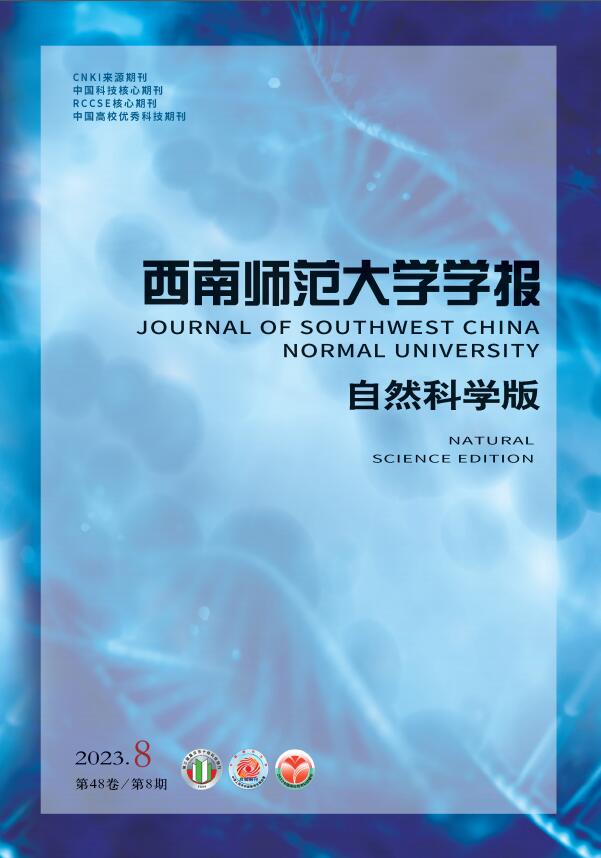-
免疫系统在抗病毒活动中发挥着非常重要的作用. 在病毒感染期间,宿主免疫系统可大致分为溶解机制和非溶解机制,溶解机制杀死感染细胞,非溶解机制通过可溶性介质抑制病毒复制[1]. 目前大量把CTL细胞免疫与溶解和非溶解效应机制相结合的病毒模型被研究[2-6], 也有许多文章结合了体液免疫反应中和游离病毒的抗病毒作用[7-12], 但很少有包含非溶解效应机制的体液免疫反应的病毒动力学模型的研究. 同时文献[13]体现了体液免疫时滞对病毒动力学有很大的影响. 基于上述讨论,本文在考虑非溶解体液免疫效应机制的同时也考虑了体液免疫时滞,构建了如下病毒动力学模型:
其中:T(t), I(t), V(t), W(t)分别表示在t时刻未感染的靶细胞、感染的靶细胞、自由病毒、体液免疫细胞的数量;A表示T细胞产生的速率;β表示感染率;k表示自由病毒产生的速率;p是体液免疫反应中和自由病毒的速率;g代表免疫细胞产生的速率. d, a, μ, h分别代表T(t), I(t), V(t), W(t)的死亡率;体液免疫应答以1+qW(t)的速率抑制病毒复制,q为抑制强度;τ表示自由病毒激发免疫反应所需的时间.
HTML
-
令C=C([-τ, 0], $\mathbb{R}_{+}^{4}$)是把区间[-τ, 0]映射到$\mathbb{R}_{+}^{4}$的连续函数的巴拿赫空间,且对于任意的ϕ∈C([-τ, 0], $\mathbb{R}_{+}^{4}$)有范数
$\|\phi\|=\sup _{-\tau \leqslant i \leqslant 0}\{|\phi(t)|\}$ . 系统(1)的初始条件如下:其中:ϕ=(φ1(θ), φ2(θ), φ3(θ), φ4(θ))∈C([-τ, 0], $\mathbb{R}_{+}^{4}$), φi(θ)≥0, θ∈[-τ, 0], 且φi(0) > 0(i=1, 2, 3, 4). 根据泛函微分方程的基本理论,易知满足初始条件(2)的系统(1)有唯一解(T(t), I(t), V(t), W(t)).
定理1 令(T(t), I(t), V(t), W(t))是满足初始条件(2)的系统(1)的解,那么T(t), I(t), V(t)和W(t)都是正的(t > 0).
证 首先证明对于t > 0, T(t)是正的. 假设T(t)不总是正的,则存在一个t0 > 0且t0=inf{t|T(t)=0, t > 0}. 由系统(1)的第一个方程可得T′(t0)=A > 0, 意味着对于充分小的ε > 0, T(t) < 0, t∈(t0-ε, t0). 矛盾. 所以对于任意的t > 0, T(t) > 0.
下面证明I(t), V(t), W(t)是正的. 假如W(t)在t0时刻第一次到达0(此时I(t), V(t)还保持为正), 由系统(1)的第四个方程可知,当t∈[0, t0]时,W(t)≥e-htW(0) > 0, 矛盾,因此W(t)不能先到达0. 假如I(t)在t1时刻第一次到达0(此时V(t), W(t)还保持为正), 那么I′(t1) > 0. 这与I(t) > 0(t < t1) 矛盾. 当V(t)在第一次到达0时(此时I(t), W(t)还保持为正), 推得相似的矛盾. 因此I(t), V(t)必须同时第一次先到达0, 并且会一直保持在0, 从而意味着I(t), V(t)是非负的. 然后从系统(1)的后三个方程可知,对于任意的t > 0,
因此,对于t > 0, 满足初始条件(2)的系统(1)的解为正.
定理2 让(T(t), I(t), V(t), W(t))是满足初始条件(2)的系统(1)的解,那么T(t), I(t), V(t)和W(t)最终一致有界,即存在M > 0, 使得对于充分大的t满足T(t) < M, I(t) < M, V(t) < M, W(t) < M.
证 让N(t)=T(t)+I(t), 那么N(t)沿着系统(1)的解的导数为
其中m=min{d, a}. 因此,
$\limsup\limits_{t \rightarrow \infty} N(t) \leqslant \frac{A}{m}$ . 其次,由系统(1)的第三个方程可知因此,
$\limsup\limits_{t \rightarrow \infty} V(t) \leqslant \frac{A k}{\mu m}$ . 然后,由系统(1)的最后一个方程可知,$\limsup\limits_{t \rightarrow \infty} V(t) \leqslant \frac{A kg}{\mu mh}$ .综上所述,T(t), I(t), V(t)和W(t)最终一致有界,且对于充分大的t有
$T(t)<M, I(t)<M$ ,$V(t)<M, W(t)<M, M=\min \left\{\frac{A}{m}, \frac{A k}{\mu m}, \frac{A k g}{\mu m h}\right\}$ .
-
首先,讨论系统(1)的平衡点的存在性. 显然系统(1)总含有一个无病平衡点E0=(T0, 0, 0, 0), 其中
$T_{0}=\frac{A}{d}$ . 定义其中R0表示在感染初期一个感染细胞在其生命周期内感染的未感染细胞的数量. 当R0 > 1, 系统(1)有唯一一个正平衡点E*=(T*, I*, V*, W*), 其中
为了研究系统(1)的平衡点
$\bar{E}=(\bar{T}, \bar{I}, \bar{V}, \bar{W})$ 的稳态,对系统(1)进行线性化,让Τ(t)=Τ(t)-T, Ι(t)=Ι(t)-I, V(t)=V(t)-V, W(t)=W(t)-W, 得到线性化后的特征方程为定理3 当R0 < 1时,无病平衡点E0是局部渐近稳定的;当R0 > 1时,无病平衡点E0是不稳定的.
证 由(3)式可得,系统(1)线性化后在E0处的特征方程为
易知,当R0 < 1时,方程(4)的所有特征根均有负实部,因此E0是局部渐近稳定的;当R0 > 1时,方程(4)有一个正实根,因此,E0是不稳定的.
定理4 当R0 < 1时,无病平衡点E0是全局渐近稳定的.
证 定义一个Lyapunov函数
V1(t)沿着系统(1)的解的导数为
因此,如果R0 < 1则
$\frac{\mathrm{d} V_{1}(t)}{\mathrm{d} t} \leqslant 0$ , 并且$\frac{\mathrm{d} V_{1}(t)}{\mathrm{d} t} \leqslant 0$ 当且仅当T(t)=T0, V(t)=0. 将V(t)=0带入系统(1)的第二个方程和第四个方程,可以得到Ι(t)→0及W(t)→0, 由LaSalle不变原理可知,当R0 < 1时,E0是全局渐近稳定的.下面讨论正平衡点E*的稳定性. 由(3)式可得,系统(1)线性化后在E*处的特征方程为
其中
定理5 当R0 > 1, τ=0时,正平衡点E*是局部渐近稳定的.
证 当τ=0时,特征方程(5)变为
其中
进一步得
其中
由Hurwitz判别法可知,特征方程(6)的所有根均有负实部,因此当R0 > 1, τ=0时,正平衡点E*是局部渐近稳定的.
定理6 当R0 > 1, τ=0时,正平衡点E*是全局渐近稳定的.
证 定义一个Lyapunov函数
V2(t)沿着系统(1)的解的导数为
其中
根据算术平均数大于等于几何平均数可知,
因此
$\frac{\mathrm{d} V_{2}(t)}{\mathrm{d} t} \leqslant 0$ , 并且$\frac{\mathrm{d} V_{2}(t)}{\mathrm{d} t} = 0$ , 当且仅当Τ(t)=Τ*,$\frac{T^{*}}{T(t)}=\frac{I^{*} T(t) V(t)\left(1+q W^{*}\right)}{I(t) T^{*} V^{*}(1+q W(t))}=\frac{I V^{*}}{I^{*} V}= \frac{1+q W(t)}{1+q W^{*}}=1$ , W(t)=W*, 即T(t)=T*, I(t)=I*, V(t)=V*, W(t)=W*. 由LaSalle不变原理可知,当R0 > 1, τ=0时,E*是全局渐近稳定的.当τ > 0时,特征方程如(5)所示. 假设方程(5)有一个纯虚根λ=iω(ω > 0). 把λ=iω带入(5)并进行实虚部分离可得
把(7)中两个方程分别平方并相加可得
其中
让s=ω2,得到如下方程
定义
根据文献[14]中四次多项式根的分布结果得到以下结论.
引理1 对于方程(9), 有以下结论成立:
(i) 如果k4 < 0, 那么方程(9)至少有一个正根;
(ii) 如果k4 > 0: 若D≥0, 那么方程(9)有正根当且仅当s1 > 0和H(s1) < 0; 若D < 0, 那么方程(9)有正根当且仅当至少存在一个s*∈{s1, s2, s3}使得s* > 0和H(s*)≤0.
其中
不失一般性,假设方程(9)有n(n∈{1, 2, 3, 4})个正根,定义为sk*(k=1, 2, …, n). 那么方程(8)也有n个正根
$\omega_{k}=\sqrt{s_{k}^{*}}(k=1, 2, \cdots, n)$ . 由方程(7)的两个方程可以得到如果ω=ωk(k=1, 2, …, n), 从(10)式解得
当τ=τk(j), k=1, 2, …, n, j=0, 1, 2, …, ±iωk为方程(5)的一对纯虚根. 显然,对于任意的k=1, 2, …, n, j=0, 1, 2, …, {τk(j)}是单调递增的并且
$\lim\limits_{j \rightarrow+\infty} \tau_{k}^{(j)}=\infty$ . 因此,存在一个k0∈{1, 2, …, n}和j0∈{0, 1, 2, …}使得定义
让λ(τ)=α(τ)+iω(τ)为方程(5)的一个根,且此根满足α(τ0)=0, ω(τ0)=ω0. 方程(5)对于τ的微分为
由(13)式可得
因此
显然H′(sk)和
$\left\{\frac{\mathrm{dRe}(\lambda(\tau))}{\mathrm{d} \tau}\right\}_{\tau=\tau_{k}^{(j)}}$ 符号相同,所以,当H′(sk)≠0, 系统(1)在τ=τ0处发生分支,并且当τ > τ0时系统(1)出现周期解. 综上所述我们得到以下结论.定理7 让s0, ω0, τ0如(12)所定义,
(i) 如果以下条件都不满足:
(a) k4 < 0;
(b) k4≥0, D≥0, s1 > 0且H(s1) < 0;
(c) k4≥0, D < 0且存在一个s*∈{s1, s2, s3}使得s* > 0同时H(s*)≤0,
则对于任意的τ > 0, 方程(5)的所有根都具有负实部,所以E*是局部渐近稳定的;
(ii) 如果(i)中(a), (b), (c)任意一个条件满足,那么当τ∈(0, τ0)时,E*是局部渐近稳定的;
(iii) 如果(i)中(a), (b), (c)任意一个条件成立且H′(sk)≠0, 那么当τ > τ0时,E*是不稳定的,并且当τ穿过临界值τ0时,系统(1)产生周期解.
-
首先通过数值模拟讨论非溶解体液免疫抑制对正平衡点E*的影响. 从R0的表达式可以看出非溶解抑制强度q与其无关,另外,根据定理6可知q对正平衡点的稳定性没有影响,但从正平衡点E*=(T*, I*, V*, W*)的表达式中可以看出T*, I*, V*, W*都与q相关. 其次也通过数值模拟检验了正平衡点E*发生Hopf分支的情况. 所有参数值都在文献[12-13]相似范围内给出,令:A=6; d=1.5; β=1; a=7.5; k=5; μ=0.3; p=3.8; g=9.2; h=5.3; q=0.5. 由此可得,R0=8.888 9 > 1, 因此正平衡点E*存在,且E*={3.521 7, 0.095 7, 0.247 5, 0.429 6}. 另外通过计算可知τ0=0.847 1.
图 1显示随着q的增加,未感染细胞(T*)的数量增加,感染细胞(I*)、自由病毒(V*)及免疫细胞(W*)的数量都减少了. 从而表明体液免疫的非溶解效应机制除了有抑制病毒复制的作用,还可能有治愈感染细胞的作用,这与文献[12]中非溶解机制治愈感染细胞的理论相一致,同时从图中可以看出非溶解的抑制也会增加免疫细胞自身的损耗.
由图 2可以看出,当τ∈(0, τ0), 例如τ=0.8, 正平衡点E*是局部稳定的;从图(3)可以看出,当τ > τ0, 例如τ=1.5, E*是不稳定的并且产生了周期解.
-
本文主要研究了非溶解体液免疫效应机制对病毒动力学的影响. 通过构造合适的Lyapunov函数以及应用LaSalle不变原理证明了当R0 < 1, τ≥0时,无病平衡点E0是全局渐近稳定的;当R0 > 1, τ=0时,正平衡点E*是全局渐近稳定的. 通过理论分析和数值模拟表明虽然非溶解抑制强度对基本再生数R0和平衡点的稳定性没有影响,但其对在正平衡点E*处的T*, I*, V*, W*的数量有很大关系,未感染细胞(T*)的数量随q的增大而增加,感染细胞(I*), 自由病毒(V*)及免疫细胞(W*)的数量随q的增大而减少,从而表明非溶解体液免疫抑制虽然会增加免疫细胞自身的损耗但其可能有治愈感染细胞的作用,因此系统(1)有助于我们进一步理解病毒感染过程中非溶解效应机制对感染细胞的治愈作用[12], 这也为抗病毒活动提供有利的帮助,但仍需要进一步研究. 其次,通过数值模拟验证了当时滞取不同值时系统稳定性的变化,当R0 > 1, τ∈(0, τ0)时,E*是局部稳定的,当τ穿过某临界值τ0时,系统(1)在E*处发生Hopf分支,产生了周期解.









 DownLoad:
DownLoad: